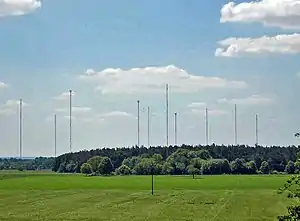
Standard frequency and time signal service (short: SFTS) is, according to Article 1.53 of the International Telecommunication Union's (ITU) Radio Regulations (RR),[1] "A radiocommunication service for scientific, technical and other purposes, providing the transmission of specified frequencies, time signals, or both, of stated high precision, intended for general reception".
Classification
In accordance with ITU Radio Regulations (article 1) variations of this radiocommunication service are classified as follows:
Standard frequency and time signal service (article 1.53)
In general this radiocommunication service uses radio stations as follows:
- Standard frequency and time signal stations (article 1.95)
Frequency allocation
The allocation of radio frequencies is provided according to Article 5 of the ITU Radio Regulations (edition 2012).[2]
In order to improve harmonisation in spectrum utilisation, the majority of service-allocations stipulated in this document were incorporated in national Tables of Frequency Allocations and Utilisations which is with-in the responsibility of the appropriate national administration. The allocation might be primary, secondary, exclusive, and shared.
- primary allocation: is indicated by writing in capital letters (see example below)
- secondary allocation: is indicated by small letters
- Example of frequency allocation
| Allocation to services | ||
| Region 1 | Region 2 | Region 3 |
| 19.95–20.05 MHz STANDARD FREQUENCY AND TIME SIGNAL (20 MHz) | ||
| 2 498-2 501 MHz STANDARD FREQUENCY AND TIME SIGNAL (2 500 MHz) | ||
| 4 995–5 003 MHz STANDARD FREQUENCY AND TIME SIGNAL (5 000 MHz) | ||
5 003–5 005 MHz STANDARD FREQUENCY AND TIME SIGNAL
| ||
| 9 995–10 003 MHz STANDARD FREQUENCY AND TIME SIGNAL (10 000 MHz) | ||
10 003–10 005 MHz STANDARD FREQUENCY AND TIME SIGNAL
| ||
| 14 990–15 005 MHz STANDARD FREQUENCY AND TIME SIGNAL (15 000 MHz) | ||
15 005–15 010 MHz STANDARD FREQUENCY AND TIME SIGNAL
| ||
19 990–19 995 MHz STANDARD FREQUENCY AND TIME SIGNAL
| ||
| 19 995–20 010 MHz STANDARD FREQUENCY AND TIME SIGNAL (20 000 MHz) | ||
| 24 990–25 005 MHz STANDARD FREQUENCY AND TIME SIGNAL (25 000 MHz) | ||
25 005–25 010 MHz STANDARD FREQUENCY AND TIME SIGNAL
| ||
Time signals in use
The following are the known HF time signal stations currently operational.
| Call Sign | Location | Frequencies | Time Signal Provided | Time Signal Format | Notes |
|---|---|---|---|---|---|
| ITU-R Standard Frequency and Time Signal services | |||||
| BPM | Pucheng, China | 2.5, 5, 10, & 15 MHz | ITU-R TF.768-5[3] | ||
| BSF | Chung-Li, Taiwan, Rep. of China | 5 and 15 MHz | |||
| EBC | Cádiz | 4.998 MHz | |||
| HLA | Taejon, Republic of Korea | 5 MHz | ITU-R TF.768-5[3] | ||
| IAM | Rome, Italy | 5 MHz | ITU-R TF.768-5[3] | ||
| LOL | Buenos Aires, Argentina | 5, 10, & 15 MHz | ITU-R TF.768-5[3] | ||
| MIKES | Espoo, Finland | 25 MHz | |||
| OMA | Prague, Czech Republic | 2.5 MHz | Discontinued in 1995 | ||
| PPE | Rio de Janeiro, Brazil | 10 MHz | |||
| RWM | Moscow, Russia | 4.996, 9.996, 14.996 MHz | ITU-R TF.768-5[3] | ||
| WWV | Fort Collins, Colorado, United States | 2.5, 5, 10, 15, & 20 MHz | ITU-R TF.768-5[3] | ||
| WWVH | Kekaha, Kauai, Hawaii, United States | 2.5, 5, 10, & 15 MHz | ITU-R TF.768-5[3] | ||
| YVTO | Caracas, Venezuela | 5 MHz | |||
| Time signal stations on non-standard frequencies | |||||
| CHU | Ottawa, Ontario, Canada | 3.33, 7.85, 14.67 MHz | |||
United States
The Standard Time and Frequency Signal (STFS) is a Radiocommunication service providing the transmission of specified frequency and time signal, of stated high precision, intended for general reception in the United States and beyond. The radio signals are broadcast on very precise carrier frequencies by the U.S. Naval Observatory and the National Institute of Standards and Technology (NIST), formerly the National Bureau of Standards (NBS). The technical specification of that particular service is in line to the provisions of the International Telecommunication Union's (ITU) Radio Regulations (RR)[1]
See also
References
- 1 2 ITU Radio Regulations, Section IV. Radio Stations and Systems – Article 1.53, definition: standard frequency and time signal service
- ↑ ITU Radio Regulations, CHAPTER II – Frequencies, ARTICLE 5 Frequency allocations, Section IV – Table of Frequency Allocations
- 1 2 3 4 5 6 7 "RECOMMENDATION ITU-R TF.768-5 Standard frequencies and time signals" (PDF). Archived from the original (PDF) on 2017-12-22.